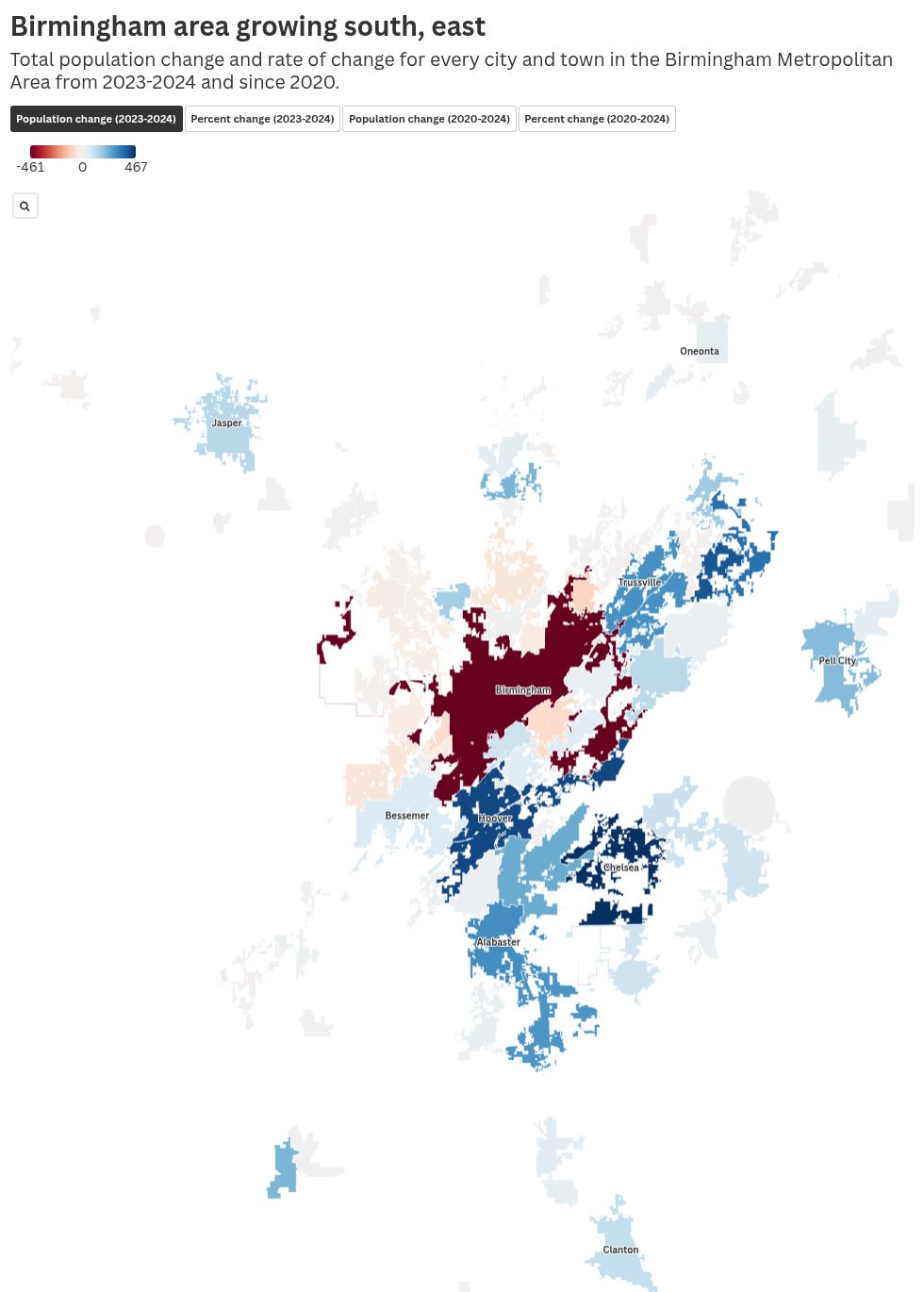Birmingham metro keeps growing in the south and east: ‘more bang for your buck’
Overall, the Birmingham Metropolitan Area is growing. But that’s not so for Birmingham proper, nor for many core cities in the heart of Alabama’s largest metro area.
As Birmingham and the over-the-mountain suburbs shrink, growth is continuing in cities further to the east and south of Birmingham, where there’s more land and homes are cheaper.
“Sometimes going out a little further gets you a little more bang for your buck, as you have more developers that are building a little further out from the city center,” said Patrick Warren, president of the Birmingham Association of Realtors.
Birmingham lost nearly 500 people in 2024, a continuation of a decades-long decline in population for the Magic City. It had roughly 4,200 fewer residents last year than were counted in the 2020 decennial census.
And it’s not the only part of the metro that’s shrinking, according to new population estimates from the U.S. Census Bureau.
[Can’t see the map? Click here.]
There are 91 cities and towns in the seven-county Birmingham metro area that are recognized by the Census Bureau. Of those, 38 have lost population since 2020, and 19 lost people last year.
Among those shrinking areas are some of the core suburbs in the metro, including Mountain Brook, which is down about 850 people since 2020, and Vestavia Hills, which is down 1,000.
Another 25 places were essentially stagnant, adding 10 or fewer people last year. Most areas in the center and north of the metro either shrank or barely grew in recent years.
It’s a different story to the south and east.
Areas far to the south of Birmingham proper, including cities like Chelsea, Helena and Calera are all growing quickly. Chelsea has grown by more than 14% since 2020, the fastest growing city in the metro area.
In the eastern part of the metro, Pell City, Margaret and Trussville are all growing, too.
Warren said more people are buying homes in communities like these because there are more houses that fit the right budget.
“I certainly think that inventory is something that is a part of that conversation, because of obviously, when it comes to purchasing real estate, it’s all circumstantial,” Warren said.
Warren added that it’s all about what matters to homebuyers – and that’s really shifted since 2020. What matters could be swayed by life circumstances, like finding a good school system for kids or becoming empty nesters and needing to downsize.
But while most of the growth is located in those southern and eastern areas, every county in the metro grew last year. It’s the first time that’s happened in more than a decade. So where did that growth come from?
In Jefferson County, where many of the larger cities are shrinking, 2024 represented a slight reversal for a few of the larger suburbs. The parts of Vestavia Hills and Hoover that are in Jefferson County added people last year. Homewood, one of the few over-the-mountain suburbs that’s been growing since 2020, added people, too.
But the biggest population boost came from areas outside cities. Unincorporated Jefferson County added 326 people last year, more than any individual city or town. That helped offset losses in 16 of the county’s 39 cities, including a loss of more than 400 people in Birmingham itself.
That doesn’t mean that Birmingham has dried up completely. Warren, who is a realtor and associate broker with ARC Realty, said he’s had several closings recently of people moving from out-of-state directly to Birmingham, prioritizing neighborhoods like Woodlawn.
“We have a lot of families moving to those areas just due to the proximity of the hospital, with UAB being one of the largest employers of our state,” he said. “A lot of people are coming in for medical opportunities, and so being in the heart of Birmingham has been a huge benefit to them.”
